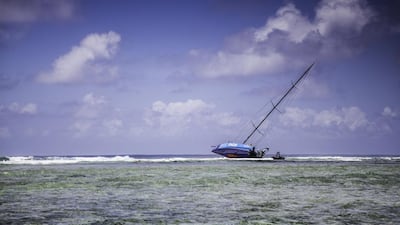It remains the defining image of Leg 2, perhaps of the Volvo Ocean Race so far. Nine days into the journey from Cape Town to Abu Dhabi, two weeks before the leg ended, Team Vestas Wind ran aground on a reef nearly 300 nautical miles off the coast of Mauritius.
There the boat remains, an optical illusion in the photographs, tottering on its side at an unsustainable angle and its rudders demolished.
Remarkably, the crew escaped unhurt from the impact, which spun the boat around. Even more remarkably, given the state of the wreck, talk continues of a possible re-entry at some point in the nine-month race.
Any return is unlikely to have significant impact at the upper end of the race standings. But as a trial run for the next race, it could have its uses. Though the line-up for 2017/18 has not yet formed, race organisers remain hopeful that several of the current participants will be back.
The key to Vestas’s return is the boat. Seven boats were built for the race, so there is no new boat on which they could swiftly resume. But there are spare parts and equipment left over from the construction of the seven.
That raises the possibility of meshing what remains of their current boat with this unused equipment. The Vestas on-shore team is en route to Mauritius to assess what can be salvaged from the wreck.
“They are working on it, but it will have to depend on how much they can rescue of the boat,” said Knut Frostad, the race chief executive. “They are going out on boats to rescue as many pieces as possible because they will need some of the pieces to put a new boat together.
“We have some equipment ready because we have spare parts for the boats we built, but it’s still a huge amount of work to be happening.”
Frostad considers himself a born optimist, but the outlook is bleak even in his mind. He suggested there is no more than a 50 per cent chance of any return. Some of the logistical obstacles, of coordinating a rebuild, may prove too great. “We have a lot of people, like boatyard suppliers, who want to make it happen,” he said. “But we will have to be a little bit lucky, not have any unforeseen incidents, and also lucky with what we can rescue out there on this island.
“The team has already rescued a lot of pieces, but the more they can rescue, the better.”
The reverberations from the crash still course through the race. As he got off the boat on Saturday afternoon, the effects on Ian Walker and Azzam were obvious.
“It’s been an emotional trip because that accident to Vestas hit everybody quite hard,” Walker said. “I mean, that’s all we talked about for two weeks.”
Bouwe Bekking, who won Leg 2 with Team Brunel, had skippered Chris Nicholson as a crew member on Movistar, which had to be abandoned in the Atlantic Ocean during the 2005/06 race.
He could not believe it had happened again to the Australian. “Because we knew what kind of speeds they were doing, my biggest worry is that somebody would be badly injured, just from the impact,” he said.
“When we heard from race control that the guys were fine, we were still worrying about them sitting on a reef and how they will get off. A boat is a boat; no matter how badly it is damaged, you can build a new one.”
There also has been relief, a recognition that it was the kind of navigational mistake easily made. The route Vestas took was one, for instance, that Dongfeng Race Team’s skipper Charles Caudrelier had briefly considered.
Dongfeng sailed not far from where Vestas ran aground, as did Team SCA, later. “When I checked the navigation before, I saw this island and said it’s going to be dangerous and one can miss it,” Caudrelier said.
He said when he saw the position of Vestas, he thought his competitor would pass around the leeward side of island, the side shielded from the prevailing wind.
“We wanted to pass leeward side, but we didn’t and we thought Vestas was going to do it,” Caudrelier said. “I didn’t expect that he didn’t see it.”
osamiuddin@thenational.ae
Follow our sports coverage on twitter at @SprtNationalUAE

